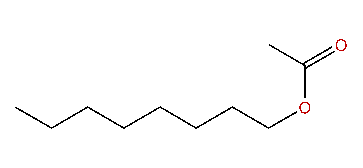
| Octyl acetate |
| Formula: | C10H20O2 |
| CAS#: | 112-14-1 |
| MW: | 172.26 |
[MS]
[ NMR ]
[ Kovats ]
[ Synthesis ]
[Occurrence in flower]
|
|
Species utilize Octyl acetate in its chemical communication system
| Heteroptera, Scutelleridae, Scutellerinae | |
| Chrysocoris purpureus |
P
�Category of the chemical signal
| A - | Attractant |
| Al - | Allomone |
| K - | Kairomone |
| P - | Pheromone |
| Sy - | Synomone� |
|
�(*) indicates that compound is active�
|
|
| |
| Diptera, Tephritidae, Dacinae, Dacini | |
| Dacus ciliatus |
A
�Category of the chemical signal
| A - | Attractant |
| Al - | Allomone |
| K - | Kairomone |
| P - | Pheromone |
| Sy - | Synomone� |
|
�(*) indicates that compound is active�
|
Lesser pumpkin fly |
| |
| Heteroptera, Coreidae, Coreinae, Anisoscelidini | |
| Leptoglossus occidentalis |
P
�Category of the chemical signal
| A - | Attractant |
| Al - | Allomone |
| K - | Kairomone |
| P - | Pheromone |
| Sy - | Synomone� |
|
�(*) indicates that compound is active�
|
Western conifer seed bug |
| Leptoglossus zonatus |
P
�Category of the chemical signal
| A - | Attractant |
| Al - | Allomone |
| K - | Kairomone |
| P - | Pheromone |
| Sy - | Synomone� |
|
�(*) indicates that compound is active�
|
|
| |
| Heteroptera, Coreidae, Micrelytrinae, Leptocorisini | |
| Leptocorisa apicalis |
Al
�Category of the chemical signal
| A - | Attractant |
| Al - | Allomone |
| K - | Kairomone |
| P - | Pheromone |
| Sy - | Synomone� |
|
�(*) indicates that compound is active�
|
|
| Leptocorisa oratorius |
P
�Category of the chemical signal
| A - | Attractant |
| Al - | Allomone |
| K - | Kairomone |
| P - | Pheromone |
| Sy - | Synomone� |
|
�(*) indicates that compound is active�
|
Rice ear bug |
| |
| Heteroptera, Miridae, Mirinae, Mirini | |
| Phytocoris calli |
P
�Category of the chemical signal
| A - | Attractant |
| Al - | Allomone |
| K - | Kairomone |
| P - | Pheromone |
| Sy - | Synomone� |
|
�(*) indicates that compound is active�
|
|
| Phytocoris difficilis |
P
�Category of the chemical signal
| A - | Attractant |
| Al - | Allomone |
| K - | Kairomone |
| P - | Pheromone |
| Sy - | Synomone� |
|
�(*) indicates that compound is active�
|
|
| |
| Hymenoptera, Andrenidae, Andreninae, Andrenini | |
| Andrena haemorrhoa |
P
�Category of the chemical signal
| A - | Attractant |
| Al - | Allomone |
| K - | Kairomone |
| P - | Pheromone |
| Sy - | Synomone� |
|
�(*) indicates that compound is active�
|
Orange-tailed mining-bee |
| Andrena nigroaenea |
P
�Category of the chemical signal
| A - | Attractant |
| Al - | Allomone |
| K - | Kairomone |
| P - | Pheromone |
| Sy - | Synomone� |
|
�(*) indicates that compound is active�
|
Buffish mining-bee |
| |
| Hymenoptera, Apidae, Apinae, Apinini | |
| Apis dorsata |
P
�Category of the chemical signal
| A - | Attractant |
| Al - | Allomone |
| K - | Kairomone |
| P - | Pheromone |
| Sy - | Synomone� |
|
�(*) indicates that compound is active�
|
Giant honeybee |
| Apis mellifera |
Al
�Category of the chemical signal
| A - | Attractant |
| Al - | Allomone |
| K - | Kairomone |
| P - | Pheromone |
| Sy - | Synomone� |
|
�(*) indicates that compound is active�
|
Queen honeybee |
| Apis mellifera |
P
�Category of the chemical signal
| A - | Attractant |
| Al - | Allomone |
| K - | Kairomone |
| P - | Pheromone |
| Sy - | Synomone� |
|
�(*) indicates that compound is active�
|
Queen honeybee |
| |
| Hymenoptera, Halictidae, Halictinae, Augochlorini | |
| Augochloropsis electra |
Al
�Category of the chemical signal
| A - | Attractant |
| Al - | Allomone |
| K - | Kairomone |
| P - | Pheromone |
| Sy - | Synomone� |
|
�(*) indicates that compound is active�
|
|
| |
| Rodentia, Cricetidae, Cricetinae, Cricetini | |
| Phodopus sungorus sungorus |
P
�Category of the chemical signal
| A - | Attractant |
| Al - | Allomone |
| K - | Kairomone |
| P - | Pheromone |
| Sy - | Synomone� |
|
�(*) indicates that compound is active�
|
Djungarian hamster |
| |
|







